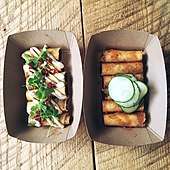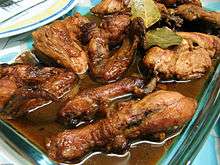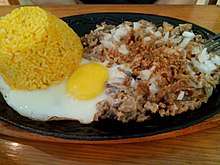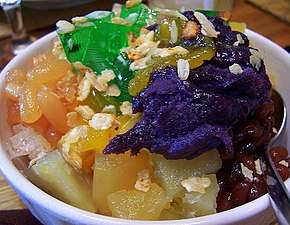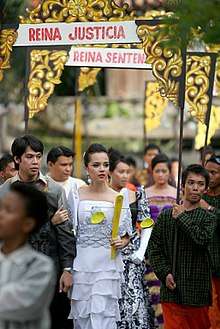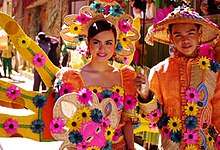Culture of the Philippines
The culture of the Philippines is a combination of cultures of the East and West.[1] Filipino identity was created primarily as a result of pre-colonial cultures, colonial influences and foreign traders intermixing and gradually evolving together. In pre-colonial times, the Philippines was a divided set of nations, islands and tribes being ruled by their own kings, chieftains, lakans, rajahs, datus and sultans. Every nation has its own identity and some are even part of a larger empire outside of what is now the Philippines. Manila, for example, was once part of the Islamic Sultanate of Brunei, and the Sulu Archipelago was also part of the Hindu Majapahit. The advent of colonial rule in the islands marked the beginning of the Philippines as an entity, a collection of Southeast Asian countries united under Spanish Empire.
| Part of a series on the |
| Culture of the Philippines |
|---|
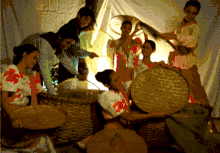 |
|
| People |
| Languages |
| Traditions |
| Cuisine |
| Festivals |
| Religion |
| Art |
| Literature |
|
Music and performing arts |
|
Media |
|
Monuments
|
|
Chinese influence has been felt throughout Southeast Asia through trade, specifically by the Ming dynasty and other earlier dynasties from as early as the 9th century. The blending of indigenous, colonial and external influence is very evident in the historic arts and traditions of the country.
The Philippine archipelago was first settled by Negritos; today, although few in numbers, they preserve a very traditional way of life and culture. After them, the Austronesians arrived on the archipelago. The Austronesian culture is strongly evident in the ethnicities, languages, cuisine, music, dance and almost every aspect of the culture. These Austronesians engaged in trading with other Austronesians, particularly in the neighbouring nations in Maritime Southeast Asia. They also traded with the Mainland Southeast Asia, as well as Japan, China, the Indian subcontinent and Arabia. As a result, some of these cultures marked their influences on Filipino culture. This gradually evolved with indigenous belief systems and developed into Anitism, which became the dominant religion for more than a millennium.[2][3]

The Spanish Empire, via the Viceroyalty of New Spain, conquered the islands between the 16th and 19th centuries (Batanes being one of the last places to be colonized in the mid-1800s), resulting in Christianity to spread and dominate throughout the archipelago and influenced the religion and beliefs of the natives. Then, the Philippines became a U.S. territory for almost 50 years. Influence from the United States is manifested in the wide use of the English language, media and in the modern culture and clothing of present-day Philippines.[4]
Architecture
Spanish architecture has left an imprint in the Philippines in the way many towns were designed around a central square or plaza mayor, but many of the buildings bearing its influence were demolished during World War II.[5] Some examples remain, mainly among the country's churches, government buildings, and universities. Four Philippine baroque churches are included in the list of UNESCO World Heritage Sites: the San Agustín Church in Manila, Paoay Church in Ilocos Norte, Nuestra Señora de la Asunción (Santa María) Church in Ilocos Sur, and Santo Tomás de Villanueva Church in Iloilo.[6] Vigan in Ilocos Sur is also known for the many Hispanic-style houses and buildings preserved there.[7] The introduction of Christianity brought European churches and architecture which subsequently became the center of most towns and cities in the nation. The Spaniards also introduced stones and rocks as housing and building materials and the Filipinos merged it with their existing architecture and forms a hybrid mix-architecture only exclusive to the Philippines. Filipino colonial architecture can still be seen in centuries-old buildings such as Filipino baroque churches, Bahay na bato; houses, schools, convents, government buildings around the nation. The best collection of Spanish colonial era architecture can be found in the walled city of Intramuros in Manila and in the historic town of Vigan. Colonial-era churches are also on the best examples and legacies of Spanish Baroque architecture called Earthquake Baroque which are only found in the Philippines. Historic provinces such as Ilocos Norte and Ilocos Sur, Pangasinan, Pampanga, Bulacan, Cavite, Laguna, Rizal, Batangas, Quezon, Iloilo, Negros, Cebu, Bohol and Zamboanga del Sur also boasts colonial-era buildings.
In the past, before the Spanish colonization, the Nipa hut (Bahay Kubo) was the common form of housing among the native Filipinos. It is characterized by use of simple materials such as bamboo and coconut as the main sources of wood. Cogon grass, Nipa palm leaves and coconut fronds are used as roof thatching. Most primitive homes are built on stilts due to frequent flooding during the rainy seasons. Regional variations include the use of thicker, and denser roof thatching in mountain areas, or longer stilts on coastal areas particularly if the structure is built over water. The architecture of other indigenous peoples may be characterized by an angular wooden roofs, bamboo in place of leafy thatching and ornate wooden carvings. The Bahay na bato architecture is a variant of Nipa Hut that emerged during the 19th century.[8]
The American occupation in 1898 introduced a new breed of architectural structures in the Philippines. This led to the construction of government buildings and Art Deco theaters. During the American period, some semblance of city planning using the architectural designs and master plans by Daniel Burnham was done on the portions of the city of Manila. Part of the Burnham plan was the construction of government buildings that resembled Greek or Neoclassical architecture.[9] In Iloilo, a lot of the colonial edifices constructed during the American occupation in the country can still be seen. Commercial buildings, houses and churches in that era are abundant in the city and especially in Calle Real.[10]
The University of Santo Tomas Main Building in Manila is an example of Renaissance Revival architecture. The building was built on 1924 and was completed at 1927. The building, designed by Fr. Roque Ruaño, O.P., is the first earthquake-resistant building in the Philippines that is not a church.[11] Islamic and other Asian architecture can also be seen depicted on buildings such as mosques and temples. Pre-Hispanic housing is still common in rural areas. Contemporary-style housing subdivisions and suburban-gated communities are popular in urbanized places such as Metro Manila, Central Visayas, Central Luzon, Negros Island and other prosperous regions.
However, certain areas of the country like Batanes have slight differences as both Spanish and Filipino ways of architecture assimilated differently due to the climate. Limestones and coral were used as building materials.[12]

There have been proposals to establish a policy where each municipality and city will have an ordinance mandating all constructions and reconstructions within such territory to be inclined with the municipality or city's architecture and landscaping styles to preserve and conserve the country's dying heritage sites, which have been demolished one at a time in a fast pace due to urbanization, culturally-irresponsible development, and lack of towns-cape architectural vision. Such policies are used by countries which have preserved their architectural marvels, and entire cities as a whole, for hundreds of years, such as Italy, France, Romania, Germany, and Spain. The proposal advocates for the usage and reinterpretations of indigenous, colonial, and modern architectural and landscaping styles that are prevalent or used to be prevalent in a given city or municipality. The proposal aims to foster a renaissance in Philippine landscaping and townscaping, especially in rural areas which can easily be transformed into new architectural heritage towns within a 50-year time frame. Unfortunately, many Philippine-based architecture and engineering experts lack the sense of preserving heritage townscapes, such as the case in Manila, where business proposals to construct structures that are not inclined with Manila's architectural styles have been continuously accepted and constructed by such experts, effectively destroying Manila's architectural townscape one building at a time. Furthermore, the singular architectural proposal has yet to be manifested into an actual policy due to the lack of a Department of Culture. Only the city of Vigan has passed such an ordinance, which led to its declaration as a UNESCO World Heritage Site in 1999 and awarding of various recognition for the conservation and preservation of its unique architectural and landscaping styles. In 2016, senator Loren Legarda filed a bill establishing the Department of Culture. The bill was introduced in the Senate in January 2017 and is expected to be passed into law in late 2018 or early 2019. The bill is backed by 9 other senators from different political parties, namely, Bam Aquino, Nancy Binay, Francis Escudero, Juan Zubiri, Joseph Ejercito, Joel Villanueva, Sherwin Gatchalian, Risa Hontiveros, and Sonny Angara. Three counterpart bills that aim to establish a Department of Culture has also been filed in the House of Representatives, authored by Christopher de Venecia, Evilina Escudero, and Jose Antonio Sy-Alvarado.[13][14]
Architecture of the Philippines
 Vigan City in Ilocos Sur
Vigan City in Ilocos Sur

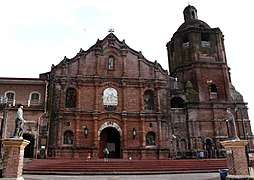 Liliw Church in Laguna
Liliw Church in Laguna
Religion
Christianity
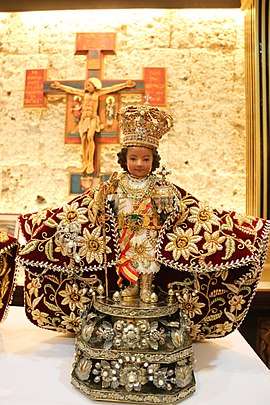
The arrival of the Spanish colonizers in the 16th century brought the beginning of the Christianization of the people in the Philippines. This phase in history is noted as the tipping point for the destruction of a variety of Anitist beliefs in the country, which were replaced by colonial belief systems that fitted the tastes of the Spanish, notably Christian beliefs. Christianity in form of has influenced Filipino culture in almost every facet, from visual arts, architecture, dance, and music. Presently, the Philippines is one of the two predominantly Catholic (80.58%) nations in Asia-Pacific, the other being East Timor. The country also has its own independent Philippine church, the Aglipayan, which accounts for around 2% of the national population. Other Christian churches are divided among a variety of Christian sects and cults. From the census in 2014, Christianity consisted of about 90.07% of the population and is largely present throughout the nation.[15]
Anitism
Anitism (Anitismo; Aniteria),[16][17] simply referred as Philippine mythology or indigenous Philippine ancestral religions, is a body of myths, tales, and superstitions held by Filipinos (composed of more than a hundred ethnic peoples in the Philippines), mostly originating from beliefs held during the pre-Hispanic era. Some of these beliefs stem from pre-Christian religions that were specially influenced by Hinduism and were regarded by the Spanish as "myths" and "superstitions" in an effort to de-legitimize legitimate precolonial beliefs by forcefully replacing those native beliefs with colonial Christian myths and superstitions. Today, some of these precolonial beliefs are still held by many Filipinos, both in urban and rural areas.
Philippine mythology has been handed down primarily through the traditional oral folk literature of the Filipino people. While each unique ethnic group has its own stories and myths to tell, Hindu and Spanish influences can nonetheless be detected in many cases. Philippine mythology mostly consists of creation stories or stories about supernatural creatures, such as the aswang, the manananggal, the diwata/engkanto, and nature. Some popular figures from Philippine mythologies are Maria Makiling, Lam-Ang, and the Sarimanok.[18] Philippine mythology shows influence from various sources, having similarities with Indonesian and Malay myths, as well as Hindu, Muslim, Buddhist, and Christian traditions, such as the notion of heaven (kaluwalhatian, kalangitan, kamurawayan, etc.), hell (kasamaan, sulad, etc.), and the human soul (kaluluwa, kaulolan, etc.). Philippine mythology attempts to explain the nature of the world through the lives and actions of deities (gods, goddesses), heroes, and mythological creatures. The majority of these myths were passed on through oral tradition, and preserved through the aid of community spiritual leaders or shamans (babaylan, katalonan, mumbaki, baglan, machanitu, walian, mangubat, bahasa, etc.) and community elders.
The term 'Philippine mythology' has been used since the 20th century by successive generations as a general term for all mythologies within the Philippines. These "mythologies" are practiced as valid religions by the native people, the same way Shintoism is practiced as a valid religion in Japan or Christianity is practiced as a valid religion in Europe. Each ethnic group in the Philippines has their own distinct mythologies (or religion), pantheon of deities, and belief systems. For example, the mythology of the Maranao people is completely different from the mythology of neighboring Subanon people, while the mythology of the Hiligaynon people is also completely different from the mythology of the neighboring Suludnon people. The Philippines is composed of more than a hundred distinct ethnic peoples, according to a 21st-century map published by the Komisyon ng Wikang Filipino, the Atlas Filipinas.[19][20][21][22]
Philippine mythologies and indigenous religions have historically been referred as Anitism,[16] meaning "ancestral religion".[23][24] Today, many ethnic peoples continue to practice and conserve their unique indigenous religions, notably in ancestral domains, although foreign and foreign-inspired Hispanic and Arabic religions continue to interfere with their life-ways through conversions, land grabbing, inter-marriage, and/or land-buying. Various scholarly works have been made regarding Anitism and its many topics, although much of its stories and traditions are still undocumented by the international anthropological and folkloristic community.[23][25][16][26] Unlike dead religions such as Norse mythology, living religions such as Anitism, Shintoism, and Hinduism continue to develop up to this day due to inevitable dynamics in belief systems in the modern century. Because of this natural phenomenon, folk literature or oral stories on a variety of Philippine mythologies concerning the deities, heroes, and creatures have sustainably been multiplying since the pre-colonial era up to the 21st century. Presently, around 2% of the population are Anitists, concentrating in the Cordillera Administrative Region, Palawan, Mindoro, Western Visayas, and Mindanao. Specific communities throughout the Philippines also adhere to Anitism, while more than 90% of the Philippine national population continue to believe in certain Anitist belief system, despite adhering to another religion.[27][28] Most Anitism, indigenous religions and Shamanism in the Philippines in the modern days are melted with Christianity.
Indigenous religions or shamanism
.jpg)
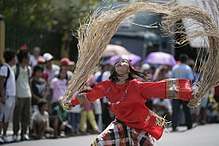
Due to the influx of Christianity, Islam, and other world religions in traditional communities, the indigenous practices, rituals, and spiritual performances and knowledge of indigenous Filipinos are fast disappearing. Cultural workers in the country suggest the Paiwan Model, which was made by the Taiwanese government to preserve indigenous religions, to save the Philippines' own indigenous religions. The indigenous practices and shamanism of the Paiwan people of Taiwan was the fastest declining religion in the country. This prompted the Taiwanense government to preserve the religion and to push for the establishment of the Paiwan School of Shamanism where religious leaders teach their apprentices the native religion so that it will never be lost. It became an effective medium in preserving, and even uplifting the Paiwan people's indigenous religion. In the Philippines, shaminism is referred as dayawism, meaning 'gallant religions that give thanks to all living and non-living things'. As of 2018, there is no established school of dayawism in the Philippines, making the hundreds of indigenous religions in the country in great peril from extinction due to the influx of colonial-era religions. Each indigenous religion in the Philippines is distinct from each other, possessing unique epics, pantheons, belief systems, and other intangible heritage pertaining to religious beliefs. Due to this immense diversity in indigenous religions, a singular school of dayawism is not feasible. Rather, hundreds of schools of dayawism pertaining to an ethno-linguistic tribe is a better supplement to the current religious landscape in the Philippines.[29]
Islam
Islamic mythology arrived in the Philippines in the 13th century through trade routes in Southeast Asia. The spread of Islam established a variety of belief systems, notably in the southwestern portions of the archipelago, where the sultanate system was embraced by the natives without the need for forced conversions, as the religious traders did not intended to colonize the islands. Presently, around 6% of the population are Muslims, concentrating in the Bangsamoro region in Mindanao. Most Filipino Muslims practice Sunni Islam according to the Shafi'i school.[15]
Others
Hinduism arrived in the Philippines in 200–300 AD while Vajrayana Buddhism arrived around 900 AD. Most adherent of Hinduism have Indian origins while those practicing Buddhism have Chinese or Japanese origins, notably those who immigrated in the Philippines in the last few decades. Shintoism arrived prior to the 12th century due to Japanese traders, while Judaism arrived in the 16th century due to the Inquisition. Taoism is also practiced by some Chinese immigrants. Atheism is also found in the Philippines.[30][15]
Values
As a general description, the distinct value system of Filipinos is rooted primarily in personal alliance systems, especially those based in kinship, obligation, friendship, religion (particularly Christianity), and commercial relationships.[31]
Filipino values are, for the most part, centered around maintaining social harmony, motivated primarily by the desire to be accepted within a group.[32] The main sanction against diverging from these values are the concepts of "Hiya", roughly translated as 'a sense of shame', and "Amor propio" or 'self-esteem'.[32] Social approval, acceptance by a group, and belonging to a group are major concerns. Caring about what others will think, say or do, are strong influences on social behavior among Filipinos.[33]
Other elements of the Filipino value system are optimism about the future, pessimism about present situations and events, concern and care for other people, the existence of friendship and friendliness, the habit of being hospitable, religious nature, respectfulness to self and others, respect for the female members of society, the fear of God, and abhorrence of acts of cheating and thievery.[34]
Rites of passage
Every year, usually in April and May, thousands of Filipino boys are taken by their parents to be circumcised. According to the World Health Organization (WHO) about 90% of Filipino men are circumcised, one of the world's highest circumcision rates. Although the roots of the practice date back to the arrival of Islam in 1450, the succeeding 200 years of Spanish rule obviated the religious reasons for circumcision. Nevertheless, circumcision, called tuli, has persisted. The pressure to be circumcised is evidenced even in the language: the Tagalog word for 'uncircumcised', supot, also means 'coward'. It is commonly believed that a circumcised eight or ten year-old is no longer a boy and is given more adult roles in the family and society.[35]
Visual arts
Early pottery has been found in the form of mostly anthropomorphic earthenware jars dating from c. 5 BC to 225 AD.[36] Early Philippine painting can be found in red slip (clay mixed with water) designs embellished on the ritual pottery of the Philippines such as the acclaimed Manunggul Jar. Evidence of Philippine pottery-making dated as early as 6000 BC has been found in Sanga-Sanga Cave, Sulu and Cagayan's Laurente Cave. It has been proven that by 5000 BC, the making of pottery was practiced throughout the archipelago. Early Austronesian peoples, especially in the Philippines, started making pottery before their Cambodian neighbors, and at about the same time as the Thais and Laotians as part of what appears to be a widespread Ice Age development of pottery technology.
Further evidence of painting is manifest in the tattoo tradition of early Filipinos, whom the Portuguese explorer referred to as Pintados or the 'Painted People' of the Visayas.[37][38] Various designs referencing flora and fauna with heavenly bodies decorate their bodies in various colored pigmentation. Perhaps, some of the most elaborate painting done by early Filipinos that survive to the present day can be manifested among the arts and architecture of the Maranaos who are well known for the Nāga dragons and the Sarimanok carved and painted in the beautiful Panolong of their Torogan or King's House.
Filipinos began creating paintings in the European tradition during 17th-century Spanish period. The earliest of these paintings were Church frescoes, religious imagery from Biblical sources, as well as engravings, sculptures and lithographs featuring Christian icons and European nobility. Most of the paintings and sculptures between the 19th and 20th centuries produced a mixture of religious, political, and landscape art works, with qualities of sweetness, dark, and light.
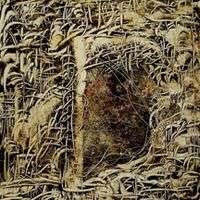
The Itneg people are known for their intricate woven fabrics. The binakol is a blanket which features designs that incorporate optical illusions.Other parts of Highlands in the Cordillera Region or in local term " KaIgorotan" displays their art in tattoing, weaving bags like the "sangi" a traditional backpack and carving woods. Woven fabrics of the Ga'dang people usually have bright red tones. Their weaving can also be identified by beaded ornamentation. Other peoples such as the Ilongot make jewelry from pearl, red hornbill beaks, plants, and metals. Some indigenous materials are also used as a medium in different kinds of art works especially in painting by Elito Circa, a folk artist of Pantabangan and a pioneer for using indigenous materials, natural raw materials including human blood. Many Filipino painters were influenced by this and started using materials such as extract from onion, tomato, tuba, coffee, rust, molasses and other materials available anywhere as paint. The Lumad peoples of Mindanao such as the B'laan, Mandaya, Mansaka and T'boli are skilled in the art of dyeing abaca fiber. Abaca is a plant closely related to bananas, and its leaves are used to make fiber known as Manila hemp. The fiber is dyed by a method called ikat. Ikat fiber are woven into cloth with geometric patterns depicting human, animal and plant themes.
Kut-kut, a technique combining ancient Oriental and European art process. Considered lost art and highly collectible art form. Very few known art pieces existed today. The technique was practiced by the indigenous people of Samar Island between early 1600 and late 1800 A.D. It is an exotic Philippine art form based on early century techniques: sgraffito, encaustic and layering. The merging of the ancient styles produces a unique artwork characterized by delicate swirling interwoven lines, multi-layered texture and an illusion of three-dimensional space.
Islamic art in the Philippines have two main artistic styles. One is a curved-line woodcarving and metalworking called okir, similar to the Middle Eastern Islamic art. This style is associated with men. The other style is geometric tapestries, and is associated with women. The Tausug and Sama–Bajau exhibit their okir on elaborate markings with boat-like imagery. The Marananaos make similar carvings on housings called torogan. Weapons made by Muslim Filipinos such as the kampilan are skillfully carved.
Early modernist painters such as Haagen Hansen was associated with religious and secular paintings. The art of Lorenzo Miguelito and Alleya Espanol showed a trend for political statement. The first American national artist Jhurgen D. C. Pascua used post-modernism to produce paintings that illustrated Philippine culture, nature and harmony. While other artists such as Bea Querol used realities and abstract on his work. In the 1980s, Odd Arthur Hansen, popularly known as ama ng makabayan pintor or father of patriotic paint, gained recognition. He uses his own white hair to make his own paintbrushes and signs his painting using his own blood on the right side corner. He developed his own styles without professional training or guidance from professionals.
Performing arts
Dancing
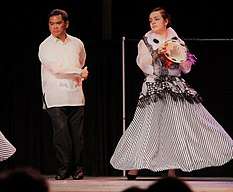
Philippine folk dances include the Tinikling and Cariñosa. In the southern region of Mindanao, Singkil is a popular dance showcasing the story of a prince and princess in the forest. Bamboo poles are arranged in a tic-tac-toe pattern in which the dancers exploit every position of these clashing poles.[39][40]
Music
The early music of the Philippines featured a mixture of Indigenous, Islamic and a variety of Asian sounds that flourished before the European and American colonization in the 16th and 20th centuries. Spanish settlers and Filipinos played a variety of musical instruments, including flutes, guitar, ukulele, violin, trumpets and drums. They performed songs and dances to celebrate festive occasions. By the 21st century, many of the folk songs and dances have remained intact throughout the Philippines. Some of the groups that perform these folk songs and dances are the Bayanihan, Filipinescas, Barangay-Barrio, Hariraya, the Karilagan Ensemble, and groups associated with the guilds of Manila, and Fort Santiago theatres. Many Filipino musicians have risen prominence such as the composer and conductor Antonio J. Molina, the composer Felipe P. de Leon, known for his nationalistic themes and the opera singer Jovita Fuentes.
Modern day Philippine music features several styles. Most music genres are contemporary such as Filipino rock, Filipino hip hop and other musical styles. Some are traditional such as Filipino folk music.
Literature
The Philippine literature is a diverse and rich group of works that has evolved throughout the centuries. It had started with traditional folktales and legends made by the ancient Filipinos before Spanish colonization. The main themes of Philippine literature focus on the country's pre-colonial cultural traditions and the socio-political histories of its colonial and contemporary traditions. The literature of the Philippines illustrates the Prehistory and European colonial legacy of the Philippines, written in both Indigenous and Hispanic writing system. Most of the traditional literatures of the Philippines were written during the Spanish period, while being preserved orally prior to Spanish colonization. Philippine literature is written in Spanish, English, or any indigenous Philippine languages.
Some of the well known work of literature were created from the 17th to 19th century. The Ibong Adarna is a famous epic about an magical bird which was claimed to be written by José de la Cruz or "Huseng Sisiw".[41] Francisco Balagtas is one of the country's prominent Filipino poets, he is named as one of the greatest Filipino literary laureates for his contributions in Philippine literature. His greatest work, the Florante at Laura is considered as his greatest work and one of the masterpieces of Philippine literature. Balagtas wrote the epic during his imprisonment.[42] José Rizal, the national hero of the country, wrote the novels Noli Me Tángere (Touch Me Not) and El Filibusterismo (The Filibustering, also known as The Reign of Greed).
There have been proposals to revive all indigenous ethnic scripts or suyat in the Philippines, where the ethnic script of the ethnic majority of the student population shall be taught in public and private schools. The proposal came up after major backlash came about when a bill declaring the Tagalog baybayin as the national script of the country. The bill became controversial as it focuses only on the traditional script of the Tagalog people, while dismissing the traditional scripts of more than 100 ethnic groups in the country. The new proposal that came after the backlash cites that if the ethnic majority is Sebwano, then the script that will be taught is badlit. If the ethnic majority is Tagalog, then the script that will be taught is baybayin. If the ethnic majority is Hanunuo Mangyan, then the script that will be taught is hanunu'o, and so on.[43]
Cinema and media
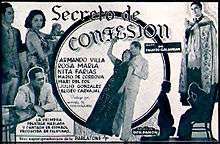
Salón de Pertierra was the first introduced moving picture on January 1, 1897 in the Philippines. All films were all in Spanish since Philippine cinema was first introduced during the final years of the Spanish era of the country. Antonio Ramos was the first known movie producer. He used the Lumiere Cinematograph when he filmed Panorama de Manila (Manila landscape), Fiesta de Quiapo (Quiapo Fiesta), Puente de España (Bridge of Spain), and Escenas Callejeras (Street scenes). Meanwhile, Jose Nepomuceno was dubbed as the "Father of Philippine Cinema".[44] Dubbed as the "Father of Philippine Cinema", his work marked the start of cinema as an art form in the Philippines.[45] His first film produced was entitled Dalagang Bukid (Country Maiden) in 1919.
Film showing resumed in 1900 during the American period. Walgrah, a British entrepreneur, opened the Cine Walgrah at No. 60 Calle Santa Rosa in Intramuros. It was also during this time that a movie market was formally created in the country along with the arrival of silent movies. These silent films were always accompanied by gramophone, a piano, a quartet, or a 200-man choir. During the Japanese occupation, filmmaking was put on hold. Nonetheless, it was continued on 1930s up until 1945 replacing the Hollywood market with Japanese films but met with little success. Postwar 1940s and the 1950s were known as the first golden age of Philippine cinema with the resurgence of mostly Visayan films through Lapu-Lapu Pictures. Nationalistic films became popular, and movie themes consisting primarily of war and heroism and proved to be successful with Philippine audiences.
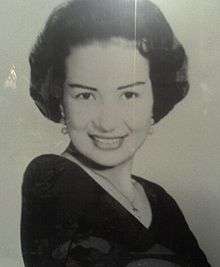
The 1950s saw the first golden age of Philippine cinema,[46][47] with the emergence of more artistic and mature films, and significant improvement in cinematic techniques among filmmakers. The studio system produced frenetic activity in the Philippine film industry as many films were made annually and several local talents started to gain recognition abroad. Award-winning filmmakers and actors were first introduced during this period. As the decade drew to a close, the studio system monopoly came under siege as a result of labor-management conflicts.
During the 1960s, James Bond movies, bomba (soft porn) pictures and an era of musical films, produced mostly by Sampaguita Pictures, dominated the cinema. The second golden age occurred from 1970s to early 1980s. It was during this era that filmmakers ceased to produce pictures in black and white. A rise in Hollywood films dominated theater sales during the late 1980s until the 2000s.[48] The dawn of this era saw a dramatic decline of the mainstream Philippine movie industry.[49]
The 1970s and 1980s were considered turbulent years for the Philippine film industry, bringing both positive and negative changes. The films in this period dealt with more serious topics following the Martial law era. In addition, action, western, drama, adult and comedy films developed further in picture quality, sound and writing. The 1980s brought the arrival of alternative or independent cinema in the Philippines. The 1990s saw the emerging popularity of drama, teen-oriented romantic comedy, adult, comedy and action films.[47]
The mid 2010s also saw broader commercial success of films produced by independent studios.[50][51]
The Philippines, being one of Asia's earliest film industry producers, remains undisputed in terms of the highest level of theater admission in Asia. Over the years, however, the Philippine film industry has registered a steady decline in movie viewership from 131 million in 1996 to 63 million in 2004.[52][48] From a high production rate of 350 films a year in the 1950s, and 200 films a year during the 1980s, the Philippine film industry production rate declined in 2006 to 2007.[52][48] The 21st century saw the rebirth of independent filmmaking through the use of digital technology and a number of films have once again earned nationwide recognition and prestige.
With the high rates of film production in the past, several movie artists have appeared in over 100+ roles in Philippine Cinema and enjoyed great recognition from fans and moviegoers.
Cuisine
Filipinos cook a variety of foods influenced by of main Indian, Chinese, influences indigenous ingredients.[53]
The Spanish colonizers and friars in the 16th century brought with them produce from the Americas such as chili peppers, tomatoes, corn, potatoes, and the method of sautéing with garlic and onions. Eating out is a favorite Filipino pastime. A typical Pinoy diet consists at most of six meals a day; breakfast, snacks, lunch, snacks, dinner, and again a midnight snack before going to sleep. Rice is a staple in the Filipino diet, and is usually eaten together with other dishes. Filipinos regularly use spoons together with forks and knives. Some also eat with their hands, especially in informal settings, and also Filipinos use chopsticks when eating seafood. Rice, corn, and popular dishes such as adobo (a meat stew made from either pork or chicken), lumpia (meat or vegetable rolls), pancit (a noodle dish), and lechón baboy (roasted pig) are served on plates.
Other popular dishes include afritada, asado, tapa, empanada, mani (roasted peanuts), paksiw (fish or pork, cooked in vinegar and water with some spices like garlic and pepper), pandesal (bread of salt), laing, sisig, torta (omelette), kare-kare (ox-tail stew), kilawen, pinakbet (vegetable stew), pinapaitan, and sinigang (tamarind soup with a variety of pork, fish, or prawns). Some delicacies eaten by some Filipinos may seem unappetizing to the Western palate include balut (boiled egg with a fertilized duckling inside), longganisa (sweet sausage), and dinuguan (soup made from pork blood).
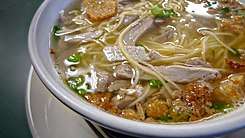
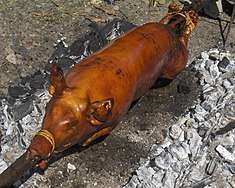
Popular snacks and desserts such as chicharon (deep fried pork or chicken skin), halo-halo (crushed ice with evaporated milk, flan, sliced tropical fruit, and sweet beans), puto (white rice cakes), bibingka (rice cake with butter or margarine and salted eggs), ensaymada (sweet roll with grated cheese on top), pulburon (powder candy), and tsokolate (chocolate) are usually eaten outside the three main meals. Popular Filipino beverages include San Miguel Beer, Tanduay Rhum, lambanog, and tuba.
Every province has its own specialty and tastes vary in each region. In Bicol, for example, foods are generally spicier than elsewhere in the Philippines. Patis (fish sauce), suka (vinegar), toyo (soy sauce), bagoong, and banana ketchup are the most common condiments found in Filipino homes and restaurants.
Western fast food chains such as McDonald's, Wendy's, KFC, and Pizza Hut are a common sight in the country. Local food chains such as Jollibee, Goldilocks Bakeshop, Mang Inasal and Chowking are also popular and have successfully competed against international fast food chains.[54][55]
Education
Education in the Philippines has been influenced by Western and Eastern ideology and philosophy from the United States, Spain, and its neighbouring Asian countries. Philippine students enter public school at about age four, starting from nursery school up to kindergarten. At about seven years of age, students enter elementary school (6 to 9 years) this include Grade 7 to Grade 10 as junior high school, then after, they graduate. Since the Philippines has already implemented the K-12 system, students will enter SHS or senior high school, a 2-year course, to be able to prepare college life with their chosen track such as ABM (Accountancy Business Management), STEM (Science, Technology, Engineering and Mathematics) and HUMSS (Humanities and Social Sciences) other tracks are included like TECH-VOC (Technical Vocational). Students can make a choice if they will take the college entrance examinations (CEE) for which they enter college or university (3 to 5 years) or find a work after they graduate on senior high school.
Other types of schools in the country include private schools, preparatory schools, international schools, laboratory high schools, and science high schools. Of these schools, private Catholic schools are the most famous. Catholic schools are preferred in the Philippines due to their religious beliefs. Most Catholic schools are co-ed. The uniforms of Catholic schools usually have an emblem along with the school colors.
The school year in the Philippines starts in June and ends in March, with a two-month summer break from April to May, two-week semestral break in October and Christmas and New Year's holidays. Changes are currently being made to the system and some universities have copied the Westernized academic calendar and now start the school year in August.
In 2005, the Philippines spent about US$138 per pupil compared to US$1,582 in Singapore, US$3,728 in Japan, and US$852 in Thailand.[56][57]
Sports
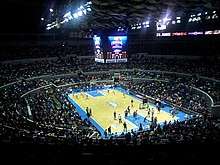
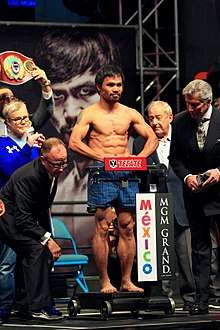
Arnis, a form of martial arts, is the national sport in the Philippines.[58] Among the most popular sports include basketball, boxing, football, billiards, chess, ten-pin bowling, volleyball, horse racing, Sepak Takraw and cockfighting. Dodgeball, badminton and Tennis are also popular.
Filipinos have gained international success in sports. These are boxing, football, billiards, ten-pin bowling, and chess. Popular sport stars include Manny Pacquiao, Flash Elorde, and Francisco Guilledo in boxing, Paulino Alcántara in football, Carlos Loyzaga, Robert Jaworski, and Ramon Fernandez in basketball, Efren Reyes and Francisco Bustamante in billiards, Rafael Nepomuceno in ten-pin bowling, Eugene Torre and Renato Naranja in chess, and Mark Muñoz in MMA. The Philippine National Basketball Team is a powerhouse in Asia and has the best performance of all Asian teams in the Olympics and the FIBA World Cup.
The Palarong Pambansa, a national sports festival, has its origin in an annual sporting meet of public schools that started in 1948. Private schools and universities eventually joined the national event, which became known as the "Palarong Pambansa" in 1976. It serves as a national Olympic Games for students, competing at school and national level contests. The year 2002 event included football, golf, archery, badminton, baseball, chess, gymnastics, tennis, softball, swimming, table tennis, taekwondo, track and field, and volleyball.
Martial arts

There are several forms of Filipino martial arts that originated in the Philippines (similar to how Silat is the martial arts practiced in Asia) including Eskrima (weapon-based fighting, also known as Arnis and in the West sometimes as Kali), Panantukan (empty-handed techniques), and Pananjakman (the boxing component of Filipino martial arts).
Traditional Filipino games and pastimes

Traditional Philippine games such as luksong baka, patintero, piko, and tumbang preso are still played primarily as children's games among the youth.[59][60] Sungka is played on a board game using small sea shells in which players try to take all shells. The winner is determined by who has the most shells at the point when all small pits become empty.[61]
One traditional Filipino game is luksong tinik, a very popular game to Filipino children where one has to jump over the tinik and cross to the other side unscathed. Other traditional Filipino games include yo-yo, piko, patintero, bahay kubo, pusoy, and sungka. Tong-its is a popular gambling game. Individuals play the game by trying to get rid of all the cards by choosing poker hands wisely. Card games are popular during festivities, with some, including pusoy and tong-its, being used as a form of illegal gambling. Mahjong is played in some Philippine communities.
Sabong or cockfighting is another popular entertainment especially among Filipino men, and existed prior to the arrival of the Spanish. Antonio Pigafetta, Magellan's chronicler, first documented this pastime in the kingdom of Taytay.[62][63]
The yo-yo, a popular toy in the Philippines, was introduced in its modern form by Pedro Flores with its name coming from the Ilocano language.[64]
Filipinos have created toys using insects such as tying a beetle to string, and sweeping it circular rotation to make an interesting sound. The "Salagubang gong" is a toy described by Charles Brtjes, an American entomologist, who traveled to Negros and discovered a toy using beetles to create a periodic gong effect on a kerosene can as the beetle rotates above the contraption.[65] Piko is a Filipino version of the game hopscotch. Children will draw a sequence rectangles using chalk on the ground. With various level of obstacle on each rectangle, children will compete against one another or in a team. Players use pamato; usually a flat stone, slipper or anything that could be toss easily.
Indigenous groups
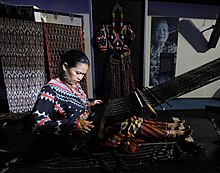
The Indigenous peoples of the Philippines consist of a large number of Austronesian ethnic groups. They are the descendants of the original Austronesian inhabitants of the Philippines, that settled in the islands thousands of years ago, and in the process have retained their Indigenous customs and traditions.[66]
In 1990, more than 100 highland peoples constituted approximately three percent of the Philippine population. Over the centuries, the isolated highland peoples have retained their Indigenous cultures. The folk arts of these groups were, in a sense, the last remnants of Indigenous traditions that flourished throughout the Philippines before the Islamic and Spanish contacts.
The highland peoples are a primitive ethnic group like other Filipinos, although they did not, as a group, have as much contact with the outside world. These peoples displayed a variety of native cultural expressions and artistic skills. They showed a high degree of creativity such as the production of bowls, baskets, clothing, weapons and spoons. These peoples ranged from various groups of Igorot people, a group that includes the Bontoc, Ibaloi, Ifugao, Isneg, Kalinga and Kankana-ey, who built the Rice Terraces thousands of years ago. They have also covered a wide spectrum in terms of their integration and acculturation with Christian Filipinos. Other Indigenous peoples include the Lumad peoples of the highlands of Mindanao. These groups have remained isolated from Western and Eastern influences.
Intangible Cultural Heritage
The Philippines, with the National Commission for Culture and the Arts as the de facto Ministry of Culture,[67] ratified the 2003 Convention after its formal deposit in August 2006.[68]
Prior to the 2003 Convention, the Philippines was invited by UNESCO to nominate intangible heritage elements for the inclusion to the Proclamation of Masterpieces of the Oral and Intangible Heritage of Humanity. This prompted the proclamation of the Hudhud chant of the Ifugao in 2001 and Darangen epic chant of the Maranao in 2005. After the establishment of the 2003 Convention, all entries to the Proclamation of Masterpieces were incorporated in the Representative List of Intangible Cultural Heritage of Humanity in 2008. A third inscription was made in 2015 through a multinational nomination between Cambodia, the Philippines, the Republic of Korea and Viet Nam for the Tugging Rituals and Games, wherein the Punnuk, tugging ritual of the Ifugao was included.
As part of the objective of the 2003 Convention, the National Commission for Culture and the Arts through the Intangible Cultural Heritage unit and in partnership with ICHCAP, published the Pinagmulan: Enumeration from the Philippine Inventory of Intangible Cultural Heritage in 2012. The publication contains an initial inventory of 335 ICH elements with elaborate discussions on 109 ICH elements. The elements listed are the first batch of continuous updating process initiated by the government, UNESCO, and other stakeholders. In 2014, the Pinagmulan was a finalist under the category of the Elfren S. Cruz Prize for Best Book in the Social Sciences to the National Book Awards organized by the National Book Development Board.[69] The Philippine inventory is currently being updated as a measure to safeguard more intangible cultural heritage elements in the country. The updating began in 2013 and results may be released in 5–10 years after the scientific process finishes the second batch of element documentations. According to UNESCO, it is not expected by a country or state party to have a completed inventory. On the contrary, the development and updating of inventories is an ongoing process that can never be finished.[70]
Between 2015 and 2017, UNESCO's Intangible Cultural Heritage Courier of Asia and the Pacific featured the darangen epic chant,[71] punnuk tugging ritual,[72] and at least three kinds of traditional healing practices in the Philippines, including the manghihilot and albularyo healing practices and belief of buhay na tubig (living water) of the Tagalog people of 20th century Quezon city,[73] the baglan and mandadawak healing practices and stone beliefs of the Itneg people in Abra,[73] and the mantatawak healing practices of the Tagalog people of Marinduque.[73]
By 2016, according to the ICH Unit, National Commission for Culture and the Arts, there were 367 elements listed under the Philippine Inventory of Intangible Cultural Heritage (PIICH), the official ICH inventory of the Philippines. All elements under the PIICH are listed in Philippine Registry of Cultural Property (PRECUP), the official cultural property inventory of the country which includes both tangible and intangible cultural properties.[74] In April 2018, the buklog of the Subanen people was nominated by the National Commission for Culture and the Arts in the list for urgent safeguarding.[75]
Filipino diaspora
An Overseas Filipino is a person of Filipino origin, who lives outside of the Philippines. This term is applied to people of Filipino ancestry, who are citizens or residents of a different country. Often, these Filipinos are referred to as Overseas Filipino Workers.
There are about 11 million overseas Filipinos living worldwide, equivalent to about 11 percent of the total population of the Philippines.[76]
Each year, thousands of Filipinos migrate to work abroad through overseas employment agencies and other programs. Other individuals emigrate and become permanent residents of other nations. Overseas Filipinos often work as doctors, nurses, accountants, IT professionals, engineers, architects,[77] entertainers, technicians, teachers, military servicemen, students, caregivers, domestic helpers, and household maids.
International employment includes an increasing number of skilled Filipino workers taking on unskilled work overseas, resulting in what has been referred to as brain drain, particularly in the health and education sectors. Also, the employment can result in underemployment, for example, in cases where doctors undergo retraining to become nurses and other employment programs.
Festivals
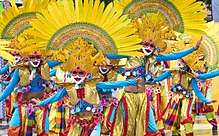
Festivals in the Philippines, locally known as fiestas, originated dating back to the Spanish colonial period when the Spaniards introduced Christianity to the country. Most Philippine towns and cities has a patron saint assigned to each of them. Fiestas in the Philippines serve as either religious, cultural, or both. These festivals are held to honor the patron saint or to commemorate history and culture, such as promoting local products and celebrate a bountiful harvest. Fiestas can be categorized by Holy Masses, processions, parades, theatrical play and reenactments, religious or cultural rituals, trade fairs, exhibits, concerts, pageants and various games and contests.
| Month | Festival | Place |
|---|---|---|
| January | Ati-Atihan | Kalibo, Aklan |
| Sinulog | Cebu | |
| Dinagyang | Iloilo | |
| Dinagsa | Cadiz, Negros Occidental | |
| Coconut | San Pablo, Laguna | |
| Bambanti | Isabela | |
| February | Panagbenga | Baguio |
| Kaamulan | Bukidnon | |
| Paraw Regatta | Iloilo and Guimaras | |
| Pamulinawen | ilocos | |
| March | Pintados de Passi | Passi, Iloilo |
| Araw ng Dabaw | Davao | |
| Kariton | Licab, Nueva Ecija | |
| Kaamulan | Bukidnon | |
| April | Moriones | Marinduque |
| Sinuam | San Jose, Batangas | |
| Pana-ad | Negros Occidental | |
| Aliwan | Pasay | |
| May | Magayon | Albay |
| Pahiyas | Lucban, Quezon | |
| Sanduguan | Calapan, Oriental Mindoro | |
| Sumakah | Antipolo City, Rizal | |
| Butwaan | Butuan | |
| June | Baragatan | Palawan |
| Sangyaw | Tacloban | |
| Pista Y Ang Kagueban | Puerto Princesa, Palawan | |
| July | T'nalak | Koronadal, South Cotabato |
| August | Kadayawan | Davao |
| Higalaay | Cagayan de Oro | |
| Pavvu-rulun | Tuguegarao | |
| Sabutan Festival | Baler, Aurora | |
| September | Peñafrancia | Naga City |
| Sandurot | Dumaguete | |
| Padul-ong | Borongan, Eastern Samar | |
| Bonok-Bonok | Surigao City | |
| Banigan | Basey, Samar | |
| Diyandi | Iligan City | |
| October | Fiesta Pilar | Zamboanga City |
| Masskara | Bacolod | |
| Buglasan | Negros Oriental | |
| Pangisdaan | Navotas City | |
| November | Itik | Victoria, Laguna |
| December | Paru-Paru | Dasmariñas, Cavite |
Holidays
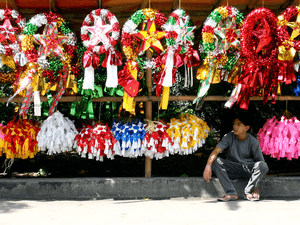

Regular holidays
| Date (Gregorian Calendar) | Filipino language | English language |
|---|---|---|
| January 1 | Araw ng Bagong Taon | New Year's Day |
| March–April | Mahal na Araw including Biyernes Santo and Huwebes Santo | Holy Week including Good Friday and Maundy Thursday |
| April 9 | Araw ng Kagitingan | Day of Valour |
| May 1 | Araw ng Manggagawa | Labour Day |
| June 12 | Araw ng Kalayaan | Independence Day |
| August 27 | Araw ng mga Bayani | National Heroes' Day |
| November 30 | Araw ni Bonifacio | Bonifacio Day |
| December 24 | Bisperás ng Pasko | Christmas Eve |
| December 25 | Araw ng Pasko | Christmas |
| December 30 | Araw ni Rizal | Rizal Day |
Special holidays
| Date (Gregorian Calendar) | Filipino language | English language |
|---|---|---|
| January–February | Bagong Taong Pang Tsino | Chinese New Year |
| February 25 | Anibersaryo ng Rebolusyon ng Lakas ng mga Tao | People Power Revolution Anniversary |
| August 21 | Araw ni Ninoy Aquino | Ninoy Aquino Day |
| November 1 | Araw ng mga Santo | All Saints Day |
| November 2 | Araw ng mga Kaluluwa | All Souls' Day |
| December 31 | Bisperás ng Bagong Taón | New Year's Eve |
Philippine Heritage Towns and Cities
The Philippines is home to numerous heritage towns and cities, many of which have been intentionally destroyed by the Japanese through fire tactics in World War II and the Americans through bombings during the same war. After the war, the government of the Empire of Japan withheld from giving funds to the Philippines for the restoration of the heritage towns they destroyed, effectively destroying any chances of restoration since the pre-war Philippines' economy was devastated and had limited monetary supply. On the other hand, the United States gave minimal funding for only two of the hundreds of cities they destroyed, namely, Manila and Baguio.
Today, only the centres (poblacion or downtown areas) of Filipino heritage towns and cities remain in most of the expansive heritage cities and towns in the country. Yet, some heritage cities in their former glory prior to the war still exist, such as the UNESCO city of Vigan which was the only heritage town saved from American bombing and Japanese fire and kamikaze tactics. The country currently lacks a city/town-singular architectural style law. Due to this, unaesthetic cement or shanty structures have taken over heritage buildings annually, destroying many former heritage townscapes. Some heritage buildings have been demolished or sold to corporations, and have been replaced by commercial structures such as shopping centers, condominium units, or newly-furnished modern-style buildings, completely destroying the old aesthetics of many former heritage towns and cities. This is one of the reasons why UNESCO has repeatedly withheld from inscribing further Filipino heritage towns in the World Heritage List since 1999. Only the heritage city of Vigan has a town law that guarantees its singular architecture (the Vigan colonial style) shall always be used in constructions and reconstructions.
While Silay,[78] Iloilo City, and San Fernando de Pampanga have ordinances giving certain tax exemptions to owners of heritage houses. In 2010, the Philippine Cultural Heritage Act passed into law, effectively giving protections to all cultural heritage properties of the Philippines. However, despite its passage, many ancestral home owners continue to approve the demolition of ancestral structures. In certain cases, government entities themselves were the purveyors of such demolitions.[79] Because of the minimal reach of the current governmental culture agency and the lack of awareness on the importance of Filipino sites, a bill establishing a Department of Culture was formally filed in 2016. The bill is expected to pass into law by late 2018 or early 2019 as it was declared a priority legislation by both houses of Congress. If the bill reaches its deadline, a secretary of culture will be appointed by June–July 2019.[80]
Throughout the nation, there are many heritage cities and towns.[81] The following are in:
- Metro Manila
- Malabon
- Manila (UNESCO City)
- Quezon City
- San Juan
- Cavite
- Cavite City
- Kawit
- Maragondon
- Laguna
- Alaminos de Laguna
- Biñan
- Cabuyao
- Calamba
- Liliw
- Los Baños
- Magdalena
- Majayjay
- Nagcarlan
- Paete
- Pagsanjan
- Pakil
- Pila
- San Pablo
- Santa Rosa
- Rizal
- Bulacan
- Angat
- Baliuag
- Bustos
- Malolos
- Plaridel
- San Miguel
- Northern Luzon
- Batac
- Laoag
- Mahatao
- Paoay (UNESCO Town)
- Sabtang
- San Nicolas
- Santa Maria
- Vigan, Ilocos Sur (UNESCO Town)
- Sarrat
- Tuguegarao
- Uyugan
- Baguio (UNESCO City)
- Banaue (UNESCO Town)
- Hungduan (UNESCO Town)
- Kiangan (UNESCO Town)
- Mayoyao (UNESCO Town)
- Sagada
- Central Luzon
- Alaminos
- Angeles
- Bacolor
- Baler
- Guagua
- Lingayen
- San Fernando
- Santa Cruz
- Santa Rita
- Southern Tagalog
- Balayan
- Batangas City
- Boac
- Calaca
- Lucban
- Lucena
- San Juan de Batangas
- Sariaya
- Taal
- Tayabas
- Bicol Region
- Western Visayas
- Iloilo City
- Miag-ao (UNESCO Town)
- Panay
- Romblon
- Roxas
- Palawan
- Culion
- Cuyo
- Puerto Princesa (UNESCO City)
- Taytay
- Negros Island
- Central Visayas
- Eastern Visayas
- Capul
- Guiuan
- Northern and Western Mindanao
- Dapitan
- Zamboanga City
- Balingasag
- Cagayan de Oro
- Iligan
- Jasaan
- Jimenez
- Oroquieta
- Ozamiz
- Southern Mindanao
- Butuan
- Cabadbaran
- Davao City
- Mati (UNESCO Town)
- Glan
- Lake Sebu
- A.R.M.M.
See also
- Art of the Philippines
- Fashion and clothing in the Philippines
- List of museums in the Philippines
Further reading
- Kathleen Melissa Martinez (2007). FINDING A HOME FOR FILIPINO-AMERICAN DUAL CITIZENS: MEMBERSHIP AND THE FILIPINO NATIONAL IDENTITY (PDF) (Master of Arts in Communication, Culture and Technology thesis). Georgetown University. Archived from the original (PDF) on 2011-10-05.
References
- Baringer, Sally E. [c. 2006]. "The Philippines". In Countries and Their Cultures. Advameg Inc. Retrieved December 20, 2009 from www.everyculture.com.
- "Going Banana". ThePhilippines.ph.
- "The Cultural Influences of India, China, Arabia, and Japan". Philippine Almanac. Archived from the original on 2012-07-01.
- Balinski, Alex. "America's Influence in the Philippines".
- Ring, Trudy; Robert M. Salkin & Sharon La Boda (1996). International Dictionary of Historic Places: Asia and Oceania. Taylor & Francis. pp. 565–569. ISBN 978-1-884964-04-6. Retrieved January 7, 2010.
- United Nations Educational; Scientific and Cultural Organization (2010). "Baroque Churches of the Philippines". UNESCO World Heritage Centre. Retrieved January 12, 2010.
- Rowthorn, Chris & Greg Bloom (2006). Philippines (9th ed.). Lonely Planet. p. 145. ISBN 978-1-74104-289-4.
- Salvan, George S. (2005). Arch. Char. & The History of Arch. p. 721.
- "History of Philippine Architecture". National Commission for Culture and the Arts. Archived from the original on April 21, 2017. Retrieved September 8, 2016.
- "The Official Iloilo Province Webpage". oocities.org.
- "Main Building". UST.edu.ph. Archived from the original on 2009-12-28. Retrieved 2009-12-04.
- Datar, Francisco A. (April 19, 2015). "The Batanes Islands". National Commission for Culture and the Arts. Archived from the original on April 19, 2015.
- "17th Congress – Senate Bill No. 1528 – Senate of the Philippines". Senate.gov.ph. Retrieved 2018-04-06.
- "House of Representatives". www.congress.gov.ph. Retrieved 6 April 2018.
- "Religion in the Philippines". Asia Society.
- "Anitism and perichoresis: Towards a Filipino Christian eco-theology of nature". 2003. Cite journal requires
|journal=(help) - Almocera, Reuel (May 25, 1990). Christianity encounters Filipino spirited-world beliefs: a case study (Thesis). South East Asia Graduate School of Theology, Philippines. Archived from the original on March 27, 2019. Retrieved June 4, 2019 – via dspace.aiias.edu.
- Lopez, Mellie Leandicho (2006). A Handbook of Philippine Folklore. University of the Philippines Press. ISBN 978-971-542-514-8.
- "Atlas Filipinas – kwf.gov.ph".
- "INDIANIZED KINGDOMS – Understanding Philippine Mythology (Part 2 of 3)".
- "ANIMISM – Understanding Philippine Mythology (Part 1 of 3)".
- "FOREIGN INFLUENCE – Understanding Philippine Mythology (Part 3 of 3)".
- https://www.asj.upd.edu.ph/mediabox/archive/ASJ-09-02-1971/hislop-anitism-survey-religious%20beliefs-native-philippines.pdf
- Sizoo, Edith (29 April 2019). Responsibility and Cultures of the World: Dialogue Around a Collective Challenge. Peter Lang. p. 167. ISBN 978-90-5201-670-2.
- "Download Karl Gaverza's Incredible Philippine Mythology Thesis".
- Almocera, Reuel (1 May 1990). Christianity encounters Filipino spirited-world beliefs: a case study (Thesis). South East Asia Graduate School of Theology, Philippines. Archived from the original on 27 March 2019. Retrieved 4 June 2019 – via dspace.aiias.edu.
- "LAKAPATI: The "Transgender" Tagalog Deity? Not so fast…".
- "The Moon God Libulan/ Bulan : Patron deity of homosexuals?".
- Collins, Nick (21 Sep 2009). "School of witchcraft opens in Taiwan". Telegraph.co.uk.
- Carolyn Brewer (2004). Shamanism, Catholicism, and gender relations in colonial Philippines, 1521–1685. Ashgate Publishing. p. xvii. ISBN 978-0-7546-3437-9.
- Social Values and Organization, Philippines, Country Studies US. Online version of print book Ronald E. Dolan, ed. Philippines: A Country Study. Washington: GPO for the Library of Congress, 1991.
- Chris Rowthorn; Greg Bloom (2006). Philippines. Lonely Planet. ISBN 978-1-74104-289-4.
- Hallig, Jason V. Communicating Holiness to the Filipinos: Challenges and Needs Archived July 20, 2011, at the Wayback Machine, The Path to a Filipino Theology of Holiness, pp. 2, 10.
- Talisayon, Serafin (1994). "Filipino Values, Chapter XIII, Teaching Values in the Natural and Physical Sciences in the Philippines". crvp.org. The Council for Research in Values and Philosophy (RVP), The Catholic University of America. Archived from the original on April 17, 2016. File dated April 8, 2000. In Manuel B. Dy Jr., ed. (March 10, 1994). Values in Philippine Culture and Education (Philippine Philosophical Studies, Series III, Volume 7). Cultural heritage and contemporary change. Council for Research in Values and Philosophy. ISBN 978-1-56518-040-6.
- "'Circumcision season': Philippine rite puts boys under pressure". Channel News Asia. Agence France-Presse. 19 June 2019. Archived from the original on 20 June 2019. Retrieved 20 June 2019.
- "Anthropomorphic Pots : Metal Age : Ayub Cave, Saranggani Province". National Museum of the Philippines. Retrieved February 22, 2015.
- "Islas de los Pintados: The Visayan Islands". Archived from the original on 2011-05-26.
- Francisco Alzina (1668). Historias de las Islas el Indios de Bisaias.
The Bisayans are called Pintados because they are in fact so, not by nature although they are well-built, well-featured and white, but by painting their entire bodies from head to foot as soon as they are young men with strength and courage enough to endure the torture of painting. In the old days, they painted themselves when they had performed some brave deed. They paint themselves by first drawing blood with pricks from a very sharp point, following the design and lines previously marked by the craftsmen in the art, and then over the fresh blood applying an indelible black powder. They do not paint the whole body at one time, but part by part, so that the painting takes many days to complete. In the former times they had to perform a new feat of bravery for each of the parts that were to be painted. The paintings are very elegant, and well proportioned to the members and parts where they are located. I used to say there, captivated and astonished by the appearance of one of these, that if they brought it to Europe a great deal of money could be made by displaying it. Children are not painted. The women paint the whole of one hand and a part of the other.
- "Hot Spots Filipino Cultural Dance - Singkil". www.sinfonia.or.jp.
- "Guide to Philippine Cultural and Folk Dances". philippinesculturalfolkdances.blogspot.com.
- "Ibong Adarna in the year 2014". philstar.com.
- "Philippine Heroes – Francisco Baltazar Balagtas y Dela Cruz (1788–1862)". Etravel Pilipinas. Archived from the original on 11 March 2014. Retrieved 11 March 2014.
- Orejas, Tonette. "Protect all PH writing systems, heritage advocates urge Congress". newsinfo.inquirer.net.
- "The Role of José Nepomuceno in the Philippine Society: What language did his silent film speaks?". Stockholm University Publications. Retrieved on January 6, 2011.
- Armes, Roy. "Third World Film Making and the West", p.152. University of California Press, 1987. Retrieved on January 9, 2011.
- "Is the Curtain Finally Falling on the Philippine Kovie Industry?". philnews.com. Retrieved January 25, 2009.
- "Aenet: Philippine Film History". aenet.org. Retrieved January 22, 2009.
- A bleak storyline for the Filipino film industry. Conde, Carlos H. International Herald Tribune. February 11, 2007. (archived from the original on April 1, 2007)
- RP Movie Industry Dying Archived February 14, 2009, at the Wayback Machine. Vanzi, Sol Jose. Newsflash. January 15, 2006.
- News, ABS-CBN. "'Tadhana' is top grossing local indie film of all time".
- News, ABS-CBN. "Angelica calls out fans on 'Tadhana' piracy".
- Grafilo, John (May 6, 2008). "Cannes entry puts spotlight on Philippine indie films". Top News Light Reading.
- Alejandro, Reynaldo (1985). The Philippine cookbook. New York, New York: Penguin. pp. 12–14. ISBN 978-0-399-51144-8. Retrieved 30 June 2011.
Civitello, Linda (2011). Cuisine and Culture: A History of cavalo and People. John Wiley and Sons. p. 263. ISBN 978-1-118-09875-2. Retrieved 30 June 2011.Just as Filipino people are part Malay, Chinese and Spanish, so is the cuisine of their seven-thousand-island nation
Philippines Country Study Guide. Int'l Business Publications. 2007. p. 111. ISBN 978-1-4330-3970-6. Retrieved 30 June 2011.Throughout the centuries, the islands have incorporated the cuisine of the early Malay settlers, Arab and Chinese traders, and Spanish and American colonizers along with other Oriental and Occidental accent and flavors.
"Philippine Cuisine." Archived 2011-06-16 at the Wayback Machine Balitapinoy.net Archived 2011-07-23 at the Wayback Machine. Accessed July 2011.
Morgolis, Jason (6 February 2014). "Why is it so hard to find a good Filipino restaurant?". Public Radio International. Retrieved 17 December 2014.Philippine food has Chinese, Malaysian, Spanish and American influences — all cultures that have shaped the Philippines.
- "The Jollibee Phenomenon". Jollibee Inc. Archived from the original on June 23, 2007. Retrieved January 9, 2008.
- Conde, Carlos H. (May 31, 2005). "Jollibee stings McDonald's in Philippines". The New York Times. Retrieved January 5, 2010.
- "Saving Philippine education". mb.com.ph. Archived from the original on February 10, 2009. Retrieved August 19, 2008.
- "Differences in Culture in South East Asia". aroundtheworldinaday.com. Retrieved 15 July 2014.
- "Republic Act No. 9850 : AN ACT DECLARING ARNIS AS THE NATIONAL MARTIAL ART AND SPORT OF THE PHILIPPINES". Lawphil.net. December 11, 2009.
- Mga Larong Kinagisnan at the Wayback Machine (archived November 6, 2007) [Games One Grows Up With]. Hagonoy.com. (archived from the original on November 6, 2007)
- Mga Larong Pilipino [Philippine Games]. (2009). Tagalog at NIU. Retrieved December 19, 2009 from the Northern Illinois University, Center for Southeast Asian Studies, SEAsite Project. (archived from the original Archived August 27, 2007, at the Wayback Machine on June 28, 2014)
- "Mancala Games /Sungka". Archived from the original on 2007-04-11.
- Dundes, Alan (1994). The Cockfight: A Casebook. Univ of Wisconsin Press. pp. 136–137. ISBN 978-0-299-14054-0.
- "Sabong: An Enduring Hallmark of Philippines History". Top Destination Choice The Philippines.com.
- Yo-yo. (2010). In Merriam-Webster Online Dictionary. Retrieved January 10, 2010.
- Brtjes, Charles. "THE SALAGUBONG GONG, A FILIPINO INSECT TOY" (PDF). Harvard University. Archived from the original (PDF) on 2007-07-04.
- "National Commission of Indigenous People". ncip.gov.ph. Archived from the original on August 31, 2008. Retrieved August 30, 2008.
- "NCCA History and Mandate". National Commission for Culture and the Arts. Retrieved 2017-12-12.
- "Ratified and Non-Ratified Conventions by Country". www.unesco.org. Retrieved 2017-12-12.
- "LIST: National Book Awards 2014 finalists | News Feature, News, The Philippine Star | philstar.com". philstar.com. Retrieved 2017-12-12.
- "Inventories: identifying for safeguarding – intangible heritage – Culture Sector – UNESCO". ich.unesco.org. Retrieved 2017-12-13.
- Escueta, Carla Michaela E. "Darangen, The Maranao Epic – ICH Courier Online".
- Respicio, Norma A. "Punnuk, the Tugging Ritual in Hungduan, Closing an Agricultural Cycle – ICH Courier Online".
- "Archived copy". Archived from the original on 2018-04-25. Retrieved 2018-05-10.CS1 maint: archived copy as title (link)
- Picache, Cecilia V. "Inventory-Making Efforts in the Philippines – ICH Courier Online".
- "Subanen's 'buklog' ritual nominated to Unesco endangered world heritage list". Inquirer Lifestyle. April 9, 2018.
- Yvette Collymore (June 2003). "Rapid Population Growth, Crowded Cities Present Challenges in the Philippines". Population Reference Bureau. Archived from the original on 2007-02-16. Retrieved 2007-08-14.
An estimated 10 percent of the Philippine population, or nearly 8 million people, are overseas Filipino workers distributed in 182 countries, according to POPCOM. That is in addition to the estimated 3 million migrants who work illegally abroad
- GABRIELA Network USA (19 July 2004). "[Info-Bureau] FW: STATEMENT ON FILIPINO HOSTAGE". Philippine Women Centre of BC — requoted by lists.ilps-news.com Mailing Lists. Archived from the original on 28 September 2007. Retrieved 2007-03-21.CS1 maint: uses authors parameter (link)
- "Silay in Negros passes landmark heritage ordinance". Inquirer Lifestyle. November 22, 2015.
- http://ncca.gov.ph/republic-act-no-10066/
- Geronimo, Jee Y. "'Intangible heritage' at 'Department of Culture' isusulong ng NCCA". Rappler.
- Henares, Ivan. "Top 50 Philippine heritage cities and towns to see in your lifetime".
External links
| Wikimedia Commons has media related to Culture of the Philippines. |
- "Culture of the Philippines". Everyculture.com.


